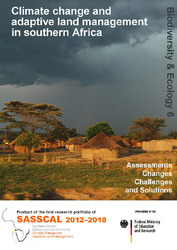Woodland resources and management in southern Africa.
Date
2018Author
De Cauwer, Vera
Knox, Nichola
Kobue-Lekalake, Rosemary
Lepetu, Joyce
Matenanga, Ompelege
Naidoo, Sasha
Nott, Amber
Parduhn, David
Sichone, Priscilla
Tshwenyane, Seoleseng
Yeboah, Elizabeth
Revermann, Rasmus
Metadata
Show full item recordAbstract
The countries of southern Africa have an average forest cover of 32% with most forest situated in the tropics. These dry to moist forests are deciduous with a few evergreen species. The open canopy allows enough light to reach the ground to allow the development of a rich grass layer. Generally, these forests are referred to as woodlands. The article gives an overview of the Miombo, Baikiaea and Mopane woodlands of Angola, Zambia, Namibia, and Botswana and focuses on their composition, wood and non-wood resources. Plantation forestry is briefly discussed with most information from South Africa, which has the largest commercial forestry sector in the region. Threats to the southern African woodlands are highlighted, and the current status of woodland monitoring and management is summarised.
Collections
- Book Chapters [9]

